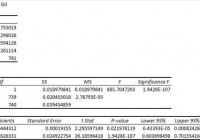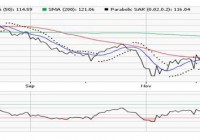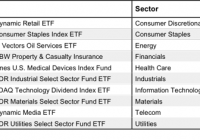GII Survives My First Round Of Cuts As Poor Liquidity Meets Strong Dividend Yields
Summary I’m taking a look at GII as a candidate for inclusion in my ETF portfolio. The expense ratio isn’t great, but it is within reason. The correlation to SPY is a huge selling point, but the poor liquidity may have made the statistics less reliable. I’m not assessing any tax impacts. Investors should check their own situation for tax exposure. Investors should be seeking to improve their risk adjusted returns. I’m a big fan of using ETFs to achieve the risk adjusted returns relative to the portfolios that a normal investor can generate for themselves after trading costs. I’m working on building a new portfolio and I’m going to be analyzing several of the ETFs that I am considering for my personal portfolio. One of the funds that I’m considering is the SPDR S&P Global Infrastructure ETF (NYSEARCA: GII ). I’ll be performing a substantial portion of my analysis along the lines of modern portfolio theory, so my goal is to find ways to minimize costs while achieving diversification to reduce my risk level. What does GII do? GII attempts to track the total return (before fees and expenses) of S&P Global Infrastructure Index. At least 80% of the assets are invested in funds included in this index. GII falls under the category of “Miscellaneous Sector”. Does GII provide diversification benefits to a portfolio? Each investor may hold a different portfolio, but I use (NYSEARCA: SPY ) as the basis for my analysis. I believe SPY, or another large cap U.S. fund with similar properties, represents the reasonable first step for many investors designing an ETF portfolio. Therefore, I start my diversification analysis by seeing how it works with SPY. I start with an ANOVA table: (click to enlarge) The correlation is excellent at 69%. I want to see low correlations on my investments. Extremely low levels of correlation are wonderful for establishing a more stable portfolio. I consider anything under 50% to be extremely low. However, for equity securities an extremely low correlation is frequently only found when there are substantial issues with trading volumes that may distort the statistics. Standard deviation of daily returns (dividend adjusted, measured since January 2012) The standard deviation is also very good. For GII it is .7760%. For SPY, it is 0.7300% for the same period. SPY usually beats other ETFs in this regard; GII is doing very well comparatively. Because the ETF has fairly low correlation for equity investments and a reasonable standard deviation of returns, it should do fairly well under modern portfolio theory. Liquidity looks fine Average trading volume is bad. The average over the last 10 days was in the ballpark of 5,000 to 6,000 shares. This represents a serious liquidity problem. As I’m writing (market open), the spread is .46%. I’d be very cautious about crossing that spread and would stick to limit orders. In my sample period (about 3 years), there were 31 days where the dividend adjusted close did not change at all. Those days may represent days in which no shares changed hands and thus a change in fair value would not be recorded. Such an event could significantly damage the reliability of the statistics for correlation and standard deviation. I will perform the rest of the analysis treating the standard deviation and correlation as being reliable and valid numbers, but investors should be aware that the poor liquidity may have significantly changed the results. Mixing it with SPY I also run comparisons on the standard deviation of daily returns for the portfolio assuming that the portfolio is combined with the S&P 500. For research, I assume daily rebalancing because it dramatically simplifies the math. With a 50/50 weighting in a portfolio holding only SPY and GII, the standard deviation of daily returns across the entire portfolio is 0.6930%. With 80% in SPY and 20% in GII, the standard deviation of the portfolio would have been .7006%. If an investor wanted to use GII as a supplement to their portfolio, the standard deviation across the portfolio with 95% in SPY and 5% in GII would have been .7210%. Why I use standard deviation of daily returns I don’t believe historical returns have predictive power for future returns, but I do believe historical values for standard deviations of returns relative to other ETFs have some predictive power on future risks and correlations. Yield & Taxes The distribution yield is 3.12%. The SEC yield is 2.90%. That appears to be a respectable yield. This ETF could be worth considering for retiring investors. I like to see strong yields for retiring portfolios because I don’t want to touch the principal. By investing in ETFs I’m removing some of the human emotions, such as panic. Higher yields imply lower growth rates (without reinvestment) over the long term, but that is an acceptable trade off in my opinion. I’m not a CPA or CFP, so I’m not assessing any tax impacts. Expense Ratio The ETF is posting .40% for a gross expense ratio, and .40% for a net expense ratio. I want diversification, I want stability, and I don’t want to pay for them. The expense ratio on this fund is higher than I want to pay for equity securities, but not high enough to make me eliminate it from consideration. I view expense ratios as a very important part of the long term return picture because I want to hold the ETF for a time period measured in decades. Market to NAV The ETF is at a .09% premium to NAV currently. Premiums or discounts to NAV can change very quickly so investors should check prior to putting in an order. Generally, I don’t trust deviations from NAV and I will have a strong resistance to paying any meaningful premium to NAV to enter into a position. While the .09% premium isn’t too bad, the spread is still a concern. Largest Holdings The diversification within the ETF is mediocre. There are 7 investments that are each over 3% of the total investments, so I’m not overly impressed by the diversification within the portfolio. The value for correlation was great for an equity security, and if that correlation was based on much higher trading volumes I would be confident enough to disregard some of the concentration within the portfolio. (click to enlarge) Conclusion I’m currently screening a large volume of ETFs for my own portfolio. The portfolio I’m building is through Schwab, so I’m able to trade GII with no commissions. I have a strong preference for researching ETFs that are free to trade in my account, so most of my research will be on ETFs that fall under the “ETF OneSource” program. The best argument for the ETF, in my opinion, is that it has a very favorable level of correlation (NYSE: LOW ) with SPY and a strong dividend yield. If further testing on the correlation supports the idea that it actually is that low (I’m doubtful), then I would rate the ETF very favorably despite a mediocre expense ratio and poor liquidity. I’m willing to deal with poor liquidity by using limit orders and watching for deviations from NAV if the ETF actually provides meaningful diversification benefits. I’ll keep GII on my list for the next round with a note to dig deeper on correlations and poor liquidity.


